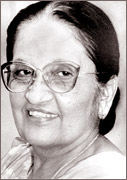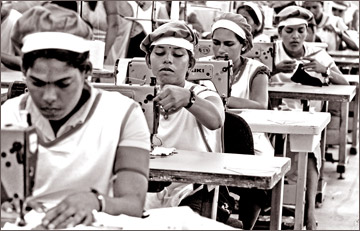The rag trade
 People with memories of the 1960s will probably remember the jingle
‘Hentley! Hentley! Shirts for you to wear, to wear!’ which was a
constant refrain on the Commercial Service of Radio Ceylon. People with memories of the 1960s will probably remember the jingle
‘Hentley! Hentley! Shirts for you to wear, to wear!’ which was a
constant refrain on the Commercial Service of Radio Ceylon.
Rointon Choksy’s Hentley Garments was a pioneer clothing exporter.
The firm sent its first shipment of shirts to the USSR in 1965, under
the Lanka-Soviet Bilateral Trade Agreement. In the late ‘60s the firm
opened the first export-oriented garment factory and also shipped shirts
to Britain, Canada, Hungary, Sweden, the USA.
Other early apparel exporters were Bernard Boteju, Candy Garments,
Favourites, Fergasam, Hentleys, Hirdaramani, Magnums, Maxims, Noortex,
Polytex Garments and Velona. Most garment manufacturers were small-scale
producers for the local market.
 |
|
Sirimavo
Bandaranaike |
Typically, Bernard Boteju started in 1948 in a corrugated iron shed
with a knitting machine and two sewing machines. In 1967, Fergasam
Garments began as a small shirt factory in Hulftsdorp, with ten pedal
operated machines.
Domestic-market
When the United Front government entered office in 1970, it laid new
emphasis on exports. Prime Minister Sirimavo Bandaranaike created an
Export Promotion Secretariat under Sivali Ratwatte - the precursor of
the Export Development Board.
In 1972, Bernard Boteju began exporting interlock t-shirts to Sweden
and women’s blouses to Britain. Fergasam began exporting shirts to
Sweden the same year. However, manufacturers continued to depend mainly
on the domestic market and the technology was somewhat less than
state-of-the-art.
The ‘Kantha Kavaya’ (‘Womens’ Circle’, an intra-United Front
organization) suggested standardising school uniforms and introducing a
range of sizes suited to Sri Lankan body shapes, in order to establish a
modern domestic-market-based clothing industry.
The concept was pushed forward by T B Ilangaratne, but proved
abortive. Clothiers had a seller’s market and profits were easy to come
by. There was little innovation and the old sweat-shop model was
retained.
Then came the modern, Japanese-inspired firms, GIL and Mayura, which
transformed the industry almost overnight. The new factories were
purpose-built and ergonomic, with modern infrastructure and good working
conditions.
They were oriented towards exports and they used imported raw
materials. The managerial staff was trained in Japan. They set a new
standard of quality. ‘Juki’ industrial sewing machines were used for the
first time.
 |
|
T B
Ilangaratne |
GIL and Mayura were the template on which modern Sri Lankan clothing
factories based themselves. Garment manufacture was no longer a
small-magnitude industry: huge economies of scale were possible with the
export market.
Economic recession
The existence of export market quotas helped the industry along. By
2005 there were 800 garment factories in the island, employing about
350,000 workers, exporting US $ 2.9 billion worth of clothing.
However, after the end that year of the multi-fibre agreement, which
guaranteed export market quotas, the garment sector was hard hit. The
number of factories shrank to 350, partly due to firms closing down and
partly to manufacturers consolidating in fewer establishments.
Nevertheless, the sector has continued to weather the storms and
uncertainties of the world economic recession and the loss of duty
concessions under the European Union’s Generalised System of
Preferences. It currently exports US $ 3.5 billion worth of garments.
The emergence of cheap labour markets in Bangladesh, Cambodia and
Vietnam lured away many foreign clothing buyers. Even some Sri Lankan
manufacturers shifted their production to these countries.
Labour shortage
However, it appears that buyers who sourced these low-cost producers
may be shifting back to Sri Lanka. The low-cost countries have not
managed to deliver the required standards of service, while this country
has a good reputation in the apparel field for reliability, quality and
cost-effectiveness.
The many travails faced by the garment industry have, by a process of
Darwinian selection, eliminated inefficient players and honed down the
sector until it is lean and mean. Nonetheless, many obstacles remain and
it is clear that the rag trade needs reform.
A major problem that has to be faced is the labour shortage. At the
Katunayake Free Trade Zone alone there are some 15,000 vacancies.
Earlier this year, a Rs 55 million advertising campaign was launched to
attract women workers to the sector. There was a similar campaign three
years ago.
Workplace injuries
The shortage is partly due to the bad image of ‘Juki girls’, but
mainly to poor wages and working and living conditions.
The basic wage is about Rs 9,000 per month, which can go up with
overtime and allowances to Rs 12,000. This is lower than today’s living
wage of Rs 20,000.
 |
|
More
employment avenues in apparel industry |
Researchers for the International Textile Garment and Leather
Workers’ Federation found that wages are low and based on productivity
targets, although by law they should be paid for days worked rather than
items produced.
They also found that prospective female employees were being forced
to take pregnancy tests (married women are not generally employed),
workers were forced to do overtime in excess of 100 hours per month and
injured workers did not get paid leave for recovery from workplace
injuries.
The expansion in the economy since the end of the war has not only
improved living standards, it has also increased expectations. When a
per-capita income of US $ 4,000 is reached, it will not be possible to
get workers even at Rs 20,000 per month.
Clothing sector
The ready-made clothing sector remains a low-value-added industry.
This is being rectified as top-end firms move towards high-value niche
goods, such as women’s underwear.
The European demand for garments shipped with a short lead time,
which command premium prices and which is currently supplied by Turkey
and East European countries, is also being targeted.
Productivity needs to be increased and wages need to keep pace. The
laggards in the industry need to learn better work practices from
leaders such as MAS and Brandix.
Ultimately, there needs to be increased automation. The penetration
of Computer Aided Design/Computer Aided Manufacturing (CAD/CAM)
facilities is insufficient. In the long term, however, the Sri Lankan
apparel industry may have to face the prospect of shifting up the
production ladder to clothing design and the manufacture of prototypes,
abandoning the actual sewing of garments.
|



